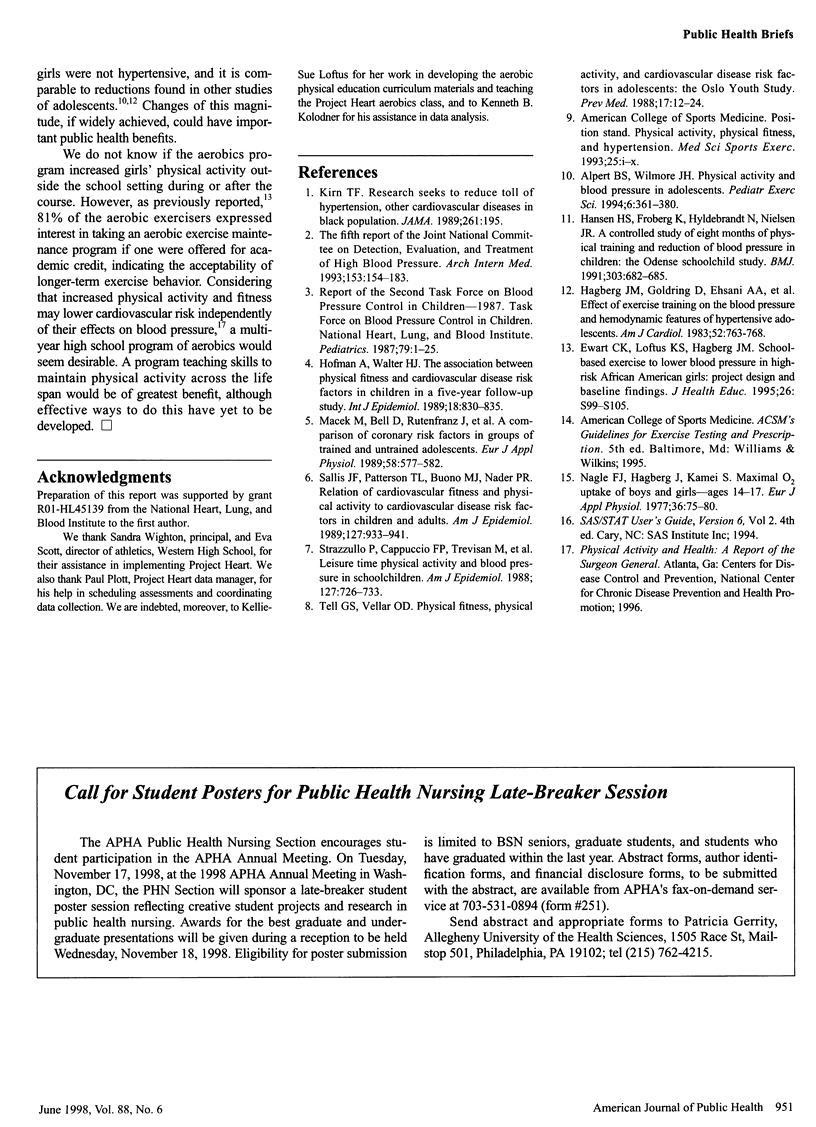Abstract
OBJECTIVES: This study evaluated the effects of aerobic exercise physical education on blood pressure in high-risk, predominantly African-American, adolescent girls. METHODS: Ninth-grade girls (n = 99) with blood pressure above the 67th percentile were randomized to 1 semester of aerobic exercise classes or standard physical education classes. RESULT: The study was completed by 88 girls. At posttest, only members of the aerobic exercise group increased their estimated cardiorespiratory fitness. The aerobic exercise group had a greater decrease in systolic blood pressure than the standard physical education group (P < .03). CONCLUSIONS: Aerobic exercise physical education is a feasible and effective health promotion strategy for high-risk adolescent girls.
Full text
PDF


Selected References
These references are in PubMed. This may not be the complete list of references from this article.
- Hagberg J. M., Goldring D., Ehsani A. A., Heath G. W., Hernandez A., Schechtman K., Holloszy J. O. Effect of exercise training on the blood pressure and hemodynamic features of hypertensive adolescents. Am J Cardiol. 1983 Oct 1;52(7):763–768. doi: 10.1016/0002-9149(83)90412-5. [DOI] [PubMed] [Google Scholar]
- Hansen H. S., Froberg K., Hyldebrandt N., Nielsen J. R. A controlled study of eight months of physical training and reduction of blood pressure in children: the Odense schoolchild study. BMJ. 1991 Sep 21;303(6804):682–685. doi: 10.1136/bmj.303.6804.682. [DOI] [PMC free article] [PubMed] [Google Scholar]
- Hofman A., Walter H. J. The association between physical fitness and cardiovascular disease risk factors in children in a five-year follow-up study. Int J Epidemiol. 1989 Dec;18(4):830–835. doi: 10.1093/ije/18.4.830. [DOI] [PubMed] [Google Scholar]
- Kirn T. F. Research seeks to reduce toll of hypertension, other cardiovascular diseases in black population. JAMA. 1989 Jan 13;261(2):195–195. [PubMed] [Google Scholar]
- Mácek M., Bell D., Rutenfranz J., Vavra J., Masopust J., Neidhart B., Schmidt K. H. A comparison of coronary risk factors in groups of trained and untrained adolescents. Eur J Appl Physiol Occup Physiol. 1989;58(6):577–582. doi: 10.1007/BF00418502. [DOI] [PubMed] [Google Scholar]
- Nagle F. J., Hagberg J., Kamei S. Maximal O2 uptake of boys and girls -- ages 14--17. Eur J Appl Physiol Occup Physiol. 1977 Jan 14;36(2):75–80. doi: 10.1007/BF00423114. [DOI] [PubMed] [Google Scholar]
- Sallis J. F., Patterson T. L., Buono M. J., Nader P. R. Relation of cardiovascular fitness and physical activity to cardiovascular disease risk factors in children and adults. Am J Epidemiol. 1988 May;127(5):933–941. doi: 10.1093/oxfordjournals.aje.a114896. [DOI] [PubMed] [Google Scholar]
- Strazzullo P., Cappuccio F. P., Trevisan M., De Leo A., Krogh V., Giorgione N., Mancini M. Leisure time physical activity and blood pressure in schoolchildren. Am J Epidemiol. 1988 Apr;127(4):726–733. doi: 10.1093/oxfordjournals.aje.a114853. [DOI] [PubMed] [Google Scholar]
- Tell G. S., Vellar O. D. Physical fitness, physical activity, and cardiovascular disease risk factors in adolescents: the Oslo Youth Study. Prev Med. 1988 Jan;17(1):12–24. doi: 10.1016/0091-7435(88)90068-0. [DOI] [PubMed] [Google Scholar]


